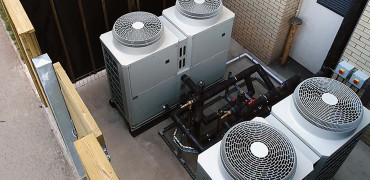As the UK’s fastest-growing residential sector, build-to-rent (BtR) projects have an opportunity to adopt low-carbon features at scale, helping developers meet and exceed today’s energy and carbon standards.
And there are strong incentives for the industry to embrace these options.
If we consider how the BtR sector works, there is a significant benefit to building owners in future-proofing their properties.
Like commercial office buildings, BtR schemes are designed primarily as financial assets – optimised returns are the critical measure of success. Future-proofing these assets against rising targets on energy use and carbon reduction is vital.
In mixed use developments heat ejected from cooling systems can provide heating elsewhere
Low-carbon = financial value
What’s more, the long-term nature of earning revenue from tenant rents also means that developers and operators have a greater interest in energy efficiency than traditional ‘build-to-sell’ residential developers.
Today’s tenants regard energy costs as a deciding factor when selecting their apartment, so energy efficiency is an important selling point.
In addition, where properties are sold from a developer to a management company, for example, the long-term value of that BtR development is a key element in its pricing.
No one wants to buy an asset that will need energy efficiency or decarbonisation upgrades in a few years. So, investment in sustainable, low-carbon technologies has a direct impact on the financial value of BtR properties.
Decarbonising hot water
For example, decarbonising heating and hot water systems is an important consideration for BtR developers. This is already a pathway set out by the government, with requirements already in place for new homes to install heat pumps by from 2025.
Modern residential air-to-water heat pump systems, such as Mitsubishi Electric’s Ecodan can achieve water temperatures of 75oC, so they are an easy swap for the traditional gas boiler.
Another option for BtR projects could be ground-source heat pumps, which operate by extracting heat energy from the earth through buried pipes. Where high-rise BtR developments carry out piling work, ground source systems could be an excellent option that can be planned in at that point.
Heat networks
In the past few years, the UK government has been promoting heat networks as an important approach to decarbonise heating and hot water. While traditional heat networks have often relied on gas boilers as the source of heat, modern low-temperature, or ambient, heat loops are a low-carbon option using heat pumps – and they have several features that would be ideal for BtR developments.
For example, Mitsubishi Electric’s Ecodan Hydrodan system is designed to deliver ambient heat loop solutions for today’s buildings. This works by circulating low-temperature water around an ambient energy loop. Temperatures are between 10oC and 30oC. Each building or apartment on the loop has a heat pump which produces domestic hot water and space heating.
The benefit of this approach is that the loop can be a heat source or a heat sink. In mixed use developments heat ejected from cooling systems, for example, can be absorbed back into the loop to provide heating elsewhere on the network.
In BtR developments with gyms, workspaces and nearby retail outlets or offices, the ambient loop approach is an opportunity to embrace the future of heating and hot water.
A great solution for BtR
Wherever they are applied, heat pumps offer a great solution for the BtR sector. They deliver energy efficient heating systems, which keeps utility costs low for tenants.
They also lower the overall carbon footprint of the building which is good for operators seeking to boost sustainable credentials.
This is a key factor for today’s BtR market. With global carbon accounting on the rise, prominent investors are leaning into their ESG commitments and require developers to achieve sustainable standards.
For example, BtR investors L&G, Aberdeen Standard and Invesco introduced requirements such as meeting BREEAM In-Use Residential Certification and other ESG criteria as far back as 2021.
BtR is in a unique position
In the fast-paced build-to-rent sector, it may seem a lot to think about taking on innovative approaches to heating and hot water. But the work required for new-build projects is far less than retrofitting these technologies into older buildings.
Mitsubishi Electric has partnered with clients in the residential market for many years. Now more than ever, our advice is to set carbon and energy efficiency targets for your projects higher than today’s regulations, because they are on an upward trajectory all the way to the 2050 net zero emissions deadline.
This includes areas such as minimum EPC requirements which are already in place, as well as future standards on building whole life carbon emissions.
Build-to-rent is in a unique position to take a forward-thinking approach as investors are increasingly aware that future-proofing their financial investments means being part of a decarbonised, electrified future.
Mike Egan is Business Development Manager




